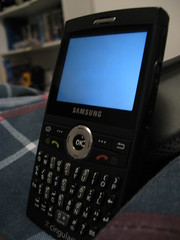 Image by Dillon K. Hoops via Flickr
Image by Dillon K. Hoops via Flickr
I was looking back at some bookmarks and materials that I had on an old computer and it was fascinating to me how the questions around technology have changed. When educators were talking a lot about the "
digital divide" back in the early 2000s, the questions were around how were we going to get these expensive machines and infrastructure to the poor. They needed lots of power, cables, expertise and money. Computers were huge and expensive and they still can be today. But we now define a whole other class of machines as computers, including phones,
netbooks and PDAs. The most important of these right now are the phones. According to
a report by the International Telecommunications Union back in March of this year, at the end of 2008 there were there were an estimated 4.1 billion phone subscriptions world-wide, compared with about 1 billion in 2002. And the definition of a phone has certainly changed since 2002. Phones now play media and connect to the internet and allow for a whole new kind of connection to learning materials. We no longer need to distribute media through CDs or laser discs. Data storage and new kinds of programming (java, ajax, web2.0 tools, etc.) combine to make distributing media easier than ever. Technology is still not absolutely universal, but the wide variety of tools that are now available for communication, the availability of netbooks for under $200, the low-cost of connectivity via WIFI and phone networks means that the real digital divide is one of the imagination. We need to bridge the gap between how we think of learning networks and teaching and the wide variety of tools and technology that are now available.
 Image by Dillon K. Hoops via Flickr
Image by Dillon K. Hoops via Flickr Image by Dillon K. Hoops via Flickr
Image by Dillon K. Hoops via Flickr
No comments:
Post a Comment